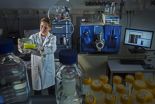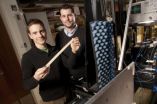(Press-News.org) WINSTON-SALEM, N.C. – Jan. 17, 2013 – Farmworkers are at potential risk from food and waterborne illnesses because of the condition of cooking and eating facilities available to them, according to a new study from Wake Forest Baptist Medical Center.
Researchers from Wake Forest Baptist are the first to evaluate cooking and eating facilities in migrant farmworker camps to compare against established housing regulations. They found that the facilities fail to comply with regulations in a substantial number of camps. The study, which appears online today in the January issue of the American Journal of Public Health, is part of an ongoing program of community-based participatory research at Wake Forest Baptist in conjunction with the N.C. Farmworkers Project, Student Action with Farmworkers and other clinics and organizations service state farmworkers.
"The structural, sanitation and pest infestation problems documented in these kitchens are interrelated," said the study's lead author Sara A. Quandt, Ph.D., a professor of epidemiology and prevention at Wake Forest Baptist.
The researchers investigated the cooking and eating facilities and collected data from 182 migrant farmworker camps in eastern North Carolina during the 2010 agricultural season. Observations were compared with 15 kitchen-related housing regulations specified by federal and state housing standards. They found violations of eight regulations in at least 10 percent of the camps across a broad spectrum – structure, water supply, kitchen equipment, sanitation and pest infestation.
The findings are important because the cooking and eating facilities can have immediate and significant effects on the workers' health, safety and work capacity, Quandt said. "Food contamination during storage or preparation, lack of appropriate kitchen facilities, and undercooking can increase the risk of foodborne illnesses. In the long term, absence of safe food storage or cooking facilities can prevent consumption of healthy foods, leading to elevated chronic disease risk."
A limitation of the study, which was supported by the National Institute of Environmental Health Sciences (grant RO1 ES012358), Quandt said, is that data were only collected in eastern North Carolina and may not represent conditions of migrant camps in other regions.
Quandt said that greater enforcement of regulations, particularly when workers occupy the facilities during the agricultural season, is needed to protect farmworkers. "Farmworker housing is a potential source of exposures that threaten workers' health and safety," she said. "Inadequate cooking and eating facilities can compromise their ability to obtain the food needed to maintain the strenuous pace of work demanded."
### END
Inadequate food facilities in NC migrant camps could cause illness
2013-01-18
ELSE PRESS RELEASES FROM THIS DATE:
A global approach to monitoring biodiversity loss
2013-01-18
In contrast to climate change, there is no coordinated global system in place for measuring and reporting on biodiversity change or loss. An international team of biologists is now addressing this gap.
In Science today, 30 researchers led by Henrique Miguel Pereira, from the Centre for Environmental Biology of the University of Lisbon, proposed a global biodiversity monitoring system based on a set of essential variables.
By determining the most essential measurements to accurately and usefully report on biodiversity loss, known as essential biodiversity variables (EBVs), ...
Weight loss helps to oust worms
2013-01-18
Scientists from The University of Manchester have discovered that weight loss plays an important role in the body's response to fighting off intestinal worms.
The findings have been published in the journal PLOS Pathogens and show that the immune system hijacks the natural feeding pathways causing weight loss. This then drives the defense mechanisms down the correct pathway to expel the worms.
Nearly one quarter of the world's population is infected with gastrointestinal parasites. These prevalent infections often result in a period of reduced appetite resulting in ...
Sniffing immune cells
2013-01-18
This press release is available in German.
Immune cells constantly patrol our body to check for foreign invaders, such as bacteria or viruses. To do so they leave the blood stream, actively crawl through tissues and finally re-enter the circulation via lymphatic vessels. Research from the laboratory of Michael Sixt elucidates how the cells are guided through tissues like the skin. It is thought that cells either sense their environment by 'touching' or 'smelling': They adhere to structural molecules like connective tissue proteins using adhesion receptors. Or ...
Separating gases using a rigid polymer sieve
2013-01-18
Gas separation is crucial for many industrial processes including obtaining nitrogen or oxygen from air and purifying natural gas or hydrogen. Currently, the most energy efficient method for separating gases involves polymer membranes, however, most polymers either let gases pass through slowly (i.e. have low permeability) or are not selective towards one gas over another. Gas separation would be cheaper and use less energy if polymer membranes could be made both highly permeable and selective.
A team from the University's School of Chemistry reports in the journal Science ...
GI tract bacteria may protect against autoimmune disease
2013-01-18
This press release is available in German.
Toronto -- Early life exposure to normal bacteria of the GI tract (gut microbes) protects against autoimmune disease in mice, according to research published on-line in the January 17 edition of Science. The study may also have uncovered reasons why females are at greater risk of autoimmune diseases such as multiple sclerosis, rheumatoid arthritis, and lupus compared to males.
Researchers from The Hospital for Sick Children (SickKids) found that when female mice at high risk of autoimmune (type 1) diabetes were exposed ...
U Alberta researchers move Barkhausen Effect forward
2013-01-18
(Edmonton) Almost 100 years after the initial discovery, a team of scientists at the University of Alberta and the National Institute for Nanotechnology in Edmonton have harnessed the Barkhausen Effect as a new kind of high-resolution microscopy for the insides of magnetic materials.
The researchers say the technique has the potential to provide critical information as a rapid prototyper for magnetic computational devices that expand the role of magnetism within computers.
In 1919, Barkhausen discovered the first evidence of magnetic domains (patterns in how the directions ...
Doubling down on energy efficiency
2013-01-18
Spending on energy efficiency programs funded by electric and natural gas utility customers will double by 2025 to about $9.5 billion per year, according to projections published today by researchers at Lawrence Berkeley National Laboratory (Berkeley Lab).
These funds, which come from a charge on utility bills, historically constitute the nation's largest source of spending on programs to foster the adoption of more efficient products and buildings. According to the Berkeley Lab report, energy efficiency programs funded by utility customers are projected to continue ...
Novel sensor provides bigger picture
2013-01-18
DURHAM, N.C. – Duke University engineers have developed a novel sensor that is more efficient, versatile and cheaper for potential use in such applications as airport security scanners and collision avoidance systems for aircraft, cars or maritime vessels.
The researchers fabricated a unique material, known as a metamaterial, that acts as a lens to image scenes using fewer components than conventional detectors. Because of the properties of this man-made material, much of the additional equipment needed for conventional detector systems – like lenses, mechanical positioners ...
Irregular heart beat elevates risk of kidney failure
2013-01-18
Many people who suffer from chronic kidney disease progressively lose their kidney function over time and eventually develop a condition called end-stage renal disease – the complete failure of the kidneys – placing them in need of lifelong dialysis or a kidney transplant.
Now researchers at the University of California, San Francisco (UCSF) and the Kaiser Permanente Northern California Division of Research have found that the risk of kidney failure is greater for people with chronic kidney disease who also have atrial fibrillation, one of the most common forms of irregular ...
Power's punishing impact
2013-01-18
Often, employees are shocked by what they think is a supervisor's severe reaction to a subordinate's seemingly minor transgression. The supervisors who punish them seem to be so absolutely sure that they are doing the right thing—they have a clear sense of purpose and there are no arguments to sway them.
New research by Scott Wiltermuth, a USC Marshall School of Business assistant professor of management and organization, and co-author Francis Flynn of the Stanford Graduate School of Business, found that providing a sense of power to someone instills a black-and-white ...




